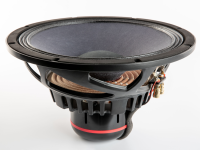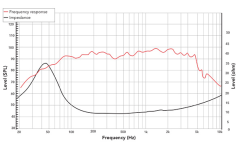You're deflecting the point, that's not what I said and your response is irrelevant. Either deal with what I really said or you can talk to yourself.Tried what? A naked compression driver without horn/waveguide?
B&C DE75/82 behind a sheet of plywood with a slightly reworked (exit) hole. Works fine from 800 Hz with just a protection cap at low output levels, but the driver obviously sounds (and works) better with a horn.
As for directivity in HF, I don't care about (hardly inevitable) increasing directivity, as long as it happens gradually/smoothly.
I don't think horn speakers are useful for near field listening, except in Camplo's specific case.
very expensive
it's $420 from speaker exchange. that's half the price of BMS and B&C and 1/3 the price of Axiperiodic.
as for being fragile just keep in mind it's a supertweeter and it will be fine.
fools be tryna cross it to a 15" woofer ... SMH ...
The D2 is used in the M2 and 4367, both 2 way speakers with 15" woofers.
yes but those are clown speakers for losers LOL
look at how that driver is used in real prosound systems. it's always crossed to a 8" midrange.
those 2-ways you mentioned are designed to work at 1/10th the SPL that prosound systems using D2 work at. it's like putting a Ferrari engine into a Minivan. JBL did it for sh*ts and giggles.
they just did it to rub in your face that their prosound driver that was never designed to sound good, only to be loud can be used in the wrongest way possible and still result in a legendary speaker because of how far JBL is above everybody else.
but don't worry. i just incorporated into one of my "end game" designs that i will post later so you can see what actual state of the art is.
i didn't previously want to use D2 because it's not officially for sale, but the fact is it's for sale whether officially or not so i can use it in my design. and it will be used as a proper supertweeter crossed to a BMS compression midrange at 2.5 khz.
if you look at how JBL uses it in a real speaker:
https://jblpro.com/en-US/site_elements/f35-95-spec-sheet
and look at beamwidth chart you can tell they crossed it at 2 khz, which is also close to the upper limit of their 8" midrange that they're crossing it to.
i would legit get this VTX for home use if it wasn't like $7,000 EACH and require a $15,000 Crown I-Tech EACH for active QUAD amping for which the I-Tech has built in presets. that would make it $45,000 total for a pair of speakers with amplification. and then you would need the subs as these only go to 60 hz and REQUIRE subs. all in you would be at about $60,000 out of which the D2 drivers would be less than $1,000 for the both of them.
those 2-ways you mentioned are TOYS compared to what the D2 was designed for. they can cross it to 15" woofer because they are running it at 10% power which is why they can also run the 15" woofer full range instead of crossing to a sub, because the woofer is also run at 10% power.
the PROPER setup for the D2 is 3-way + sub using 8" mid, two 15" woofers and dual 18" subs ( per speaker ) with about 20,000 watts of amplification for a setup using two speakers two dual 18" subs using 2269 drivers.
Last edited:
by the way the 8" midrange has push pull dual 3" voice coils and is horn loaded with its own phase plug and 4" throat.if you look at how JBL uses it in a real speaker:
https://jblpro.com/en-US/site_elements/f35-95-spec-sheet
i am just assuming that this driver cannot be purchased, at least not with the phase plug and 4" throat horn and that's why in my design it is replaced with a BMS dual 3.5" compression midrange for which there is at least some hope of finding a horn for.
the BMS has much fatter diaphragms than D2 being a dedicated midrange and with a proper horn should be happy down to 500 hz or so, but with a real life horn probably more like 700 hz.
https://www.bmsspeakers.com/index.php-98.html?id=bms_4599he0
i think Joseph Crowe tested this driver and said distortion was too high above 4 khz or something like that, but i would only use it up to 2.5 khz ...
I'm talking about the waveguide alone used down through the reactive region. No driver limitations. What does it sound like?
It's a completely hypothetical and therefore unrealistic scenario, because any compression driver capable of reproducing the highest octave is inherently (excursion) limited.
I've adequately addressed the question wrt the 'reactive region' and hereby pass it on to Alice.
here is a good midrange for D2 to cross to @ 1.5 khz:
https://audioxpress.com/article/test-bench-b-c-speakers-8nsm64-closed-back-midrange
$333 from PE - expensive for a 8" paper cone, but paired with the D2 it would be a highly optimized setup down to 250 hz, which is the FS of this closed back midrange. i believe the 8" closed back mid JBL uses has FS of 220 hz.
then just add a pair of 15" woofers and you will have a system that laughs at M2 with double the output and lower distortion. may need to fashion a waveguide for the 8" if you want optimum directivity.
you could use these woofers:
https://www.parts-express.com/JBL-2265HPL-338343-003X-15-Neo-Woofer-294-452?quantity=1
https://audioxpress.com/article/test-bench-b-c-speakers-8nsm64-closed-back-midrange
$333 from PE - expensive for a 8" paper cone, but paired with the D2 it would be a highly optimized setup down to 250 hz, which is the FS of this closed back midrange. i believe the 8" closed back mid JBL uses has FS of 220 hz.
then just add a pair of 15" woofers and you will have a system that laughs at M2 with double the output and lower distortion. may need to fashion a waveguide for the 8" if you want optimum directivity.
you could use these woofers:
https://www.parts-express.com/JBL-2265HPL-338343-003X-15-Neo-Woofer-294-452?quantity=1
Last edited:
the PROPER setup for the D2 is 3-way + sub using 8" mid, two 15" woofers and dual 18" subs ( per speaker ) with about 20,000 watts of amplification for a setup using two speakers two dual 18" subs using 2269 drivers.
Then I guess it's not for me, because at home I prefer 2 way speakers that work with 4 to 40 watts per channel 😉
Speaking of PA, over the last 20 years or so I have only come across JBL sporadically in clubs or at concerts (in Europe).
Competition has of course increased enormously, but I cannot escape the impression that JBL is squandering its heritage, especially after the takeover by Samsung.
JBL is American. It's everywhere in America.over the last 20 years or so I have only come across JBL sporadically in clubs or at concerts (in Europe)
that said i revisited Joseph Crowe's review of 4599 HE and then read his review of the regular single diaphragm mid from BMS and it makes no sense but in his tests ( and he tested two units ) the dual diaphragm has unacceptably high IMD but the single diaphragm has IMD below measurement limit of his test equipment ...
he tested them all on the same horn too ...
https://josephcrowe.com/blogs/news/bms-4599he-revisited
https://josephcrowe.com/blogs/news/bms-4591-with-horn-no-1670
so i guess if i were to use a BMS mid i would have to stick with single diaphragm though it will then not be able to keep up with SPL of the D2
or maybe it will because D2 will have to be equalized at the top end while BMS will be operating in the region where it is already most efficient
Then I guess it's not for me, because at home I prefer 2 way speakers that work with 4 to 40 watts per channel
yeah honestly you can use a much smaller compression driver for that ...
and a lower powered midrange as well ...
perhaps a 1.75" annular compression driver ( 1" exit ) and a 6.5" midrange with 44 mm voice coil
still 15" woofer though ( 3" VC ).
here is a good midrange for D2 to cross to @ 1.5 khz:
https://audioxpress.com/article/test-bench-b-c-speakers-8nsm64-closed-back-midrange
$333 from PE - expensive for a 8" paper cone, but paired with the D2 it would be a highly optimized setup down to 250 hz, which is the FS of this closed back midrange. i believe the 8" closed back mid JBL uses has FS of 220 hz.
then just add a pair of 15" woofers and you will have a system that laughs at M2 with double the output and lower distortion. may need to fashion a waveguide for the 8" if you want optimum directivity.
you could use these woofers:
https://www.parts-express.com/JBL-2265HPL-338343-003X-15-Neo-Woofer-294-452?quantity=1
For a high output (semi-pro) 3-way, these drivers should be more than sufficient.
If you want to build a slightly smaller/more modest 3-way, this 6" midrange looks interesting, although the response plot is misleading.
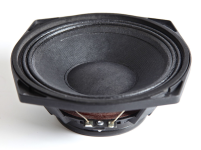
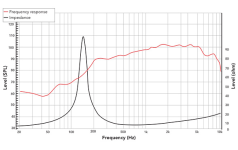
"lightweight paper pulp, specifically developed for this application. This unique cone provides the ideal weight to strength ratio."
(It's got my favorite/preferred cone & dustcap structure)
Resonant frequency: 150 Hz
Re: 6.9 ohm
Qes: 0.38
Qms: 4.58
Qts: 0.35
Vas: 2.9 liters
Sd: 143.1 cm2
Mms: 11.1 grams
Bl: 13.7
Le: 0.16 mH
Sensitivity: 96.79 dB
Last edited:
Last edited:
that said i revisited Joseph Crowe's review of 4599 HE and then read his review of the regular single diaphragm mid from BMS and it makes no sense but in his tests ( and he tested two units ) the dual diaphragm has unacceptably high IMD but the single diaphragm has IMD below measurement limit of his test equipment ...
he tested them all on the same horn too ...
https://josephcrowe.com/blogs/news/bms-4599he-revisited
https://josephcrowe.com/blogs/news/bms-4591-with-horn-no-1670
so i guess if i were to use a BMS mid i would have to stick with single diaphragm though it will then not be able to keep up with SPL of the D2
or maybe it will because D2 will have to be equalized at the top end while BMS will be operating in the region where it is already most efficient
It's no surprise the 4591 outperforms the 9599HE. A single diaphragm means less interference because only one wave front arrives at the exit tube.
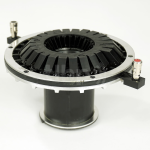
i am not familiar with this brand. what is it ? you didn't mention the model numbers for either of the two drivers.If you want to build a slightly smaller
i don't think it's that simple. they could have combined the two properly. in fact they claim they have. but something is wrong with the driver - i do not know what - but according to Crowe it is a night and day difference in IMD.It's no surprise the 4591 outperforms the 9599HE. A single diaphragm means less interference because only one wave front arrives at the exit tube.
on other had he says the dual diaphragm driver has lowest THD he has ever measured.
i honestly do not understand it but because i don't and to be safe i would stay with a single diaphragm.
it should also be cheaper, easier to replace the diaphragm and easier to find parts ( since the diaphragm is shared with coaxials, which is not the case for dual diaphragm driver that has dedicated diaphragms ).
A correct mutual coupling between the 2 (identical) diaphragms, channels and the phase plug is of utmost importance.
This requires very tight (production) tolerances – as is the case with the D2.
So while the THD may be low overall, the specific nonlinearities may show up in the IMD measurements.
This requires very tight (production) tolerances – as is the case with the D2.
So while the THD may be low overall, the specific nonlinearities may show up in the IMD measurements.
as is the case with the D2.
but with D2 the two diaphragms aren't even the same.
i wish more people would measure IMD then maybe i would be able to understand it better.
the specific nonlinearities may show up in the IMD measurements.
i think i have a theory about what could be happening ...
Joseph uses test bandwidth of 10 khz on single diaphragm and 20 khz on dual diaphragm. he also uses different SPL levels. he also admits on his single diaphragm test he had a noisy background and couldn't measure actual distortion level - only that it was below room noise floor.
he concludes that single diaphragm is "distortion free" but dual is compromised beyond what is acceptable ... when actually they could be on the same level of IMD performance.
the reason the dual looks worse is because he used a wider bandwidth test signal on a lower bandwidth driver and that IMD is subharmonic in nature produced by frequencies that should have never been applied to the driver. why is he feeding full scale 20 khz stimulus into a dedicated midrange driver ? how is that relevant to real world use ?
he then points out SB Audience has lower IMD at 4 khz ... but SB Audience is not a midrange and feeding it 20 khz is actually appropriate and it still has high IMD at the top of its range but it happens to be above 4 khz because it's a HF driver not a midrange ...
whereas 4599 is a driver tuned to lower frequencies which sees distortion rise earlier in frequency range ...
now i think it is not unreasonable to ask 4599 to deliver clean 4 khz but it IS unreasonable to feed it 20 khz tones and expect not to see any subharmonics from those when it is not designed to work at those frequencies !
test signal bandwidth should have been limited to operating range of the driver which is about 7 khz.
he even admits IMD at 500 hz is "excellent" but the bad IMD at 4 khz - how do we know it is caused by signal input at around 4 khz or signal input above 7 khz that never should have been applied to the driver ?
if we correct for bandwidth of driver and of test signal instead of feeding 20 khz into a midrange and measuring IMD at the same frequency for a midrange and HF driver then we may find all 3 drivers ( single, dual and SB audience ) are on the same level of performance as far as IMD.
one thing that doesn't add up with this theory of mine is he says with the dual BMS IMD goes up with SPL but with other drivers it does not ... based on what i know about compression driver distortion certainly goes up with SPL but i don't know how that applies to IMD specifically ...
basically Joseph has the same problem as Vance Dickason - they can't figure out how to measure distortion in a way that is actually useful
i think with real world signal dual diaphragm BMS might have the lowest overall distortion of those 3 drivers and Joseph simply isn't measuring it in a way that is relevant
Vance Dickason has the same problem where he measures subwoofers in free air for whatever reason as if that has any relevance to real world ...
one thing is clear, however - the dual diaphragm BMS doesn't like high frequencies. it is happier in the 500 hz range.
so i guess the measurements aren't completely useless. just not as useful as they could have been if measured under more realistic conditions.
Last edited:
i mean if you look at this chart

it is pretty clear the driver should be used from 500 hz to 3 khz
then he just pushes 20 khz into it to measure IMD at 4 khz and declares the driver is bad
it is pretty clear the driver should be used from 500 hz to 3 khz
then he just pushes 20 khz into it to measure IMD at 4 khz and declares the driver is bad
BMS specifically touts their "ultra low intermodulation distortion ring diaphragm" ... how likely is it that they would completely ignore IMD in their most expensive and high end driver ?
or is it more likely that the test is completely irrelevant ...
when Joseph himself admitted the driver had lowest harmonic distortion he ever measured ...
a system is either linear or it isn't - if its linear it will have no distortion of any kind and if it is nonlinear than it should also have high harmonic distortion not only IMD ...
except Joseph never measured harmonic distortion above 7 khz since those harmonics would be over 20 khz ...
so the driver may be linear below 7 khz but nonlinear above 7 khz which is likely considering it has 7 khz bandwidth and that 3rd harmonic is clearly starting to rise towards 7 khz before the chart ends there ...
feeding full scale stimulus up to 20 khz can then generate ( THIS IS PURE SPECULATION ) intermodulation subharmonics from the nonlinear region going back into the linear region showing up as poor IMD in the passband ...
again, he should have band-limited the IMD stimulus to 7 khz.
or is it more likely that the test is completely irrelevant ...
when Joseph himself admitted the driver had lowest harmonic distortion he ever measured ...
a system is either linear or it isn't - if its linear it will have no distortion of any kind and if it is nonlinear than it should also have high harmonic distortion not only IMD ...
except Joseph never measured harmonic distortion above 7 khz since those harmonics would be over 20 khz ...
so the driver may be linear below 7 khz but nonlinear above 7 khz which is likely considering it has 7 khz bandwidth and that 3rd harmonic is clearly starting to rise towards 7 khz before the chart ends there ...
feeding full scale stimulus up to 20 khz can then generate ( THIS IS PURE SPECULATION ) intermodulation subharmonics from the nonlinear region going back into the linear region showing up as poor IMD in the passband ...
again, he should have band-limited the IMD stimulus to 7 khz.
- Home
- Loudspeakers
- Multi-Way
- BMS 4592 vs Radian Beryllium
